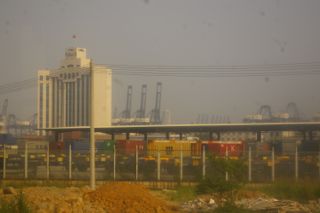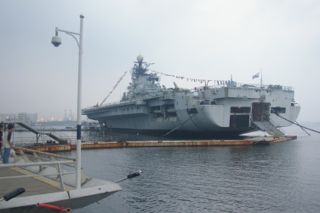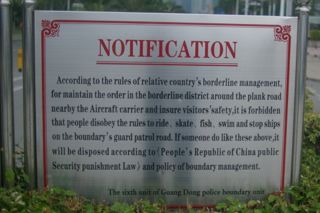A few minutes back I was glancing through Chinese trade statistics, in an attempt to put together the hopefully reasonably detailed post on what is going on in China that Brian has been nagging me to write.
With respect to Europe, the stat that pops out is that Germany runs a significant trade surplus with China, but that the eurozone as a whole and even more the EU as a whole runs a large deficit. Trade patterns with China are responsible for part of the immense stresses that now exist on the €uro. The German surplus puts upward pressure on the currency at the same time that the southern deficits put strong downwards pressure on it.
One thing that comes up is the “Hong Kong Problem” in the statistics. Many containers of Chinese exports from the factories of Shenzhen and Dongguan are carried over the border into Hong Kong, and are then shipped from the port of Hong Kong. Others are carried to the port of Shenzhen and then exported from China directly. Which port is chosen determines whether the export shows up in China’s trade surplus with America or whether it shows up in Hong Kong’s trade surplus with America. It is not difficult to simply consolidate the numbers, but this is not always done, and figures are sometimes misleading because of this. The two ports of Hong Kong and Shenzhen are only a few miles away from each other, and are at present third and fourth in the list of busiest container ports in the world, but would be the busiest by far if counted together. I had seen the port of Hong Kong many times prior to my last visit to the area in 2008, but I was curious about the port of Shenzhen, so I visited the Yantian district of Shenzhen.
After I wandered down the roads between warehouses and goods yards full of containers for a time, and took many photographs through gates, a man in a uniform gestured to me to stop and went of to consult with someone else in a more impressive uniform. At this point I thought it would be good to make myself scarce, so I departed rapidly down the road and out of the container port. (I sent a text message to a private equity fund manager friend of mine in South Africa, who urged me to keep taking photographs, as he was interested in seeing them, and because “Mike, your safety is something I am entirely willing to risk”).

But anyway, I made myself scarce. A half hour later I found myself walking along the shore past a rusting Russian aircraft carrier, which was apparently the centrepiece of a bankrupt, cold war themed theme park named “Minsk World”. After a while of this, I departed for a different area of Shenzhen, and somehow managed to end the day drinking a weissbier served to me by a young Chinese woman wearing a dirndl, while sitting on the deck of a boat that had once been Charles de Gaulle’s private yacht.
However, it was a good day. It is only on very special occasions that life gets this weird.
When buying two old Soviet aircraft carriers from the Ukrainians, the Chinese claimed that their reason for doing this was to convert them into tourist attractions. Reputedly, the actual situation was that they hoped to learn as much about aircraft carriers from them as possible, and then refit them as actual aircraft carriers. Upon discovering that they were in fact large and immense floating pieces of rust that had actually not been very good aircraft carriers in the first place, in a possible attempt to save face, the Chinese did attempt to convert them into tourist attractions after all. Thus the two Soviet military theme parks, one in Shenzhen based around the Minsk and the other in Tianjin based around the Kiev.


Both subsequently went bankrupt, a day out while looking at rusting remnants of the Soviet Union not apparently being a big attraction for the young Chinese. The Kiev carrier in Tianjin has apparently been subsequently converted into a hotel. The Minsk in Shenzhen continues to rust.). The Chinese in 1998 purchased the incomplete Admiral Kuznetsov class carrier the Varyag, which was at that point floating somewhere in the Ukrainian waters of the Black Sea. The carrier was officially bought by a Macau based tourist venture, with the pretext being that it would be converted into a casino. In this case, though, it remains in the hands of the Chinese military. After a (very) lengthy refit, it may one day enter into service in the Chinese navy.
All evidence is that the Chinese did in fact purchase Charles de Gaulle’s yacht with the intention of turning it into a floating Bavarian beer bar, however.




The German surplus puts upward pressure on the [euro] at the same time that the southern deficits put strong downwards pressure on it.
Umm, no. From the point of view of external trade, the eurozone economies are a single bloc.
The quoted statement makes as much sense as claiming that
“The Texas surplus puts upward pressure on the dollar while the California deficit puts downward pressure.”
The difference is that the eurozone states track their exports and imports separately, and so it is clear which states are running the surpluses and deficits with the outside.
Rich:
And why would that be incorrect? The fact that in the US we are looking only at the aggregate effect, while in Europe we look at separate ports, does not seem to contradict the overall effect on the currency in question.
Being served german beer by a chinese young lady in a drndrldle on de Gaulles yacht, in Hong Kong? You, sir, know how to travel.
Erm…
Just to add on to Tim Newman’s comment. The BBC article still refers to it as by the Soviet name VARYAG. She was re-christened [or however you call it when the state is officially atheist] as the SHI LANG, the name of a Chinese Admiral from the end of the Ming dynasty and early in the Ch’ing [Manchu] dynasty. She is reported to eventually be slated to carry 26 Chinese copies of the navalised version of the Sukhoi-27 “Flanker” and 24 helicopters.
Subotai Bahadur